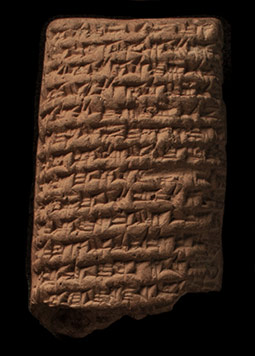Scholarly works
The written word formed the basis of all scholarly advice to the Assyrian king. Sometimes royal scholars quoted extracts from particular compositions in the letters and reports but more often learned writings formed the deep background to their thinking. Over 250 clay tablets TT containing scholarly works have been found at Nimrud since the 1950s. Here we explore what they consisted of, and how they were stored and circulated. However, we should also bear in mind that much was also written on writing-boards, which have mostly been lost forever.
Ancient advice literature
In cuneiform TT culture, scholarly learning encompassed a vast range of disciplines and genres from mythology to mathematics, medicine to mourning rituals TT . However, no one individual, family or practice community engaged with the whole range of knowledge in circulation. Each archaeological assemblage TT - or "library" - of scholarly tablets reflects personal choices and professional interests, as well as the relative availability of source material. Not surprisingly, works written and consulted in and around the Assyrian royal court predominantly concern advice and protection for the king.
Reading the future
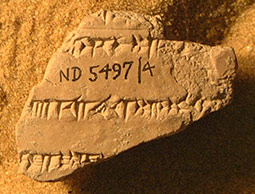
Image 1: A fragmentary tablet from Nabu's temple in Kalhu, which says it is from Chapter 72 of the omen series Šumma Alu (online translation: CTN 4: 43). British Museum, ND 5497/04. View large image (233 KB).
Almost a quarter of the Nimrud scholarly tablets contain long extracts from standard collections of omens. Most are from the series Enūma Anu Ellil TT , "When (the gods) Anu and Ellil", on the meaning of sightings in the night sky. Then there are signficant numbers of tablets from the series Šumma Ālu, "If a city" (Image 1), and Šumma Izbu, "If an anomaly", which make ominous TT meaning from observations on the ground and unexpected births.
Given the prominence of āšipu-healers in Kalhu, it is perhaps surprising that the two omen TT series traditionally associated with this profession are not well represented. Just a few tablets from Sakikkû, "Symptoms", and Alandimmû, "Physiognomy", have been identified.
There are no tablets from the sacrificial divination series Bārûtu, "The Art of Seeing", from Kalhu either, only an elegant clay model of a sheep's lung, annotated with technical terminology which was found outside the temple. But that absence is less suprising, given the low profile of bārû-diviners in the 7th-century city.
A related genre consists of ominous calendars, detailing which activities are favourable or unfavourable on particular months. The most widely attested of these is called Iqqur īpuš "he destroyed, he built".
Warding off evil
Incantations TT and rituals account for over a fifth of Kalhu's scholarly tablets. Some are to protect individuals against evil demons TT (Ardat lilî, Asakkū marṣūtu, Lamaštu, Utukkū lemnūtu) or witches (Maqlû, Šurpu). Others avert the evil portended by an omen (namburbû). Some are to be performed as acts of transformation: the consecration of a priest, the induction of a cult statue, the building of a grave. And some, such as Muššuʾu, "Rubbing", combine physical therapies like massage with ceremonial acts and utterances to effect a cure.
A rather smaller proportion of tablets contain therapeutic recipes, often used alongside incantations to deal with anything from wounds to epilepsy to witches. Lists of plants, stones, and other healing substances are also attested.
Invoking divine support
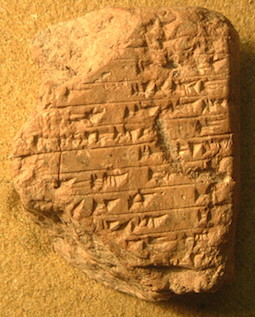
Image 2: A fragmentary catalogue of "hand-raising" (šuillakku) prayers to gods and goddesses, CTN 4: 179. British Museum, ND 4405/72. View large image (246 KB).
The 25 or so hymns and prayers found in Kalhu are precisely to those deities we might expect: to the great god Ashur and his Babylonian counterpart Ellil PGP , as well as Ellil's temple Ekur PGP ; to the warrior Ninurta; to the great goddess Ištar; to the Babylonian god Marduk PGP and his divine spouse Zarpanitu. There are šuillakku-prayers to Nabu, god of wisdom, and his spouse Tašmetu PGP , as well as Nabu's Babylonian equivalent Ea PGP (Image 2).
Sometimes it is hard to distinguish between hymns, prayers, and incantations. Take, for instance, the so-called lipšur litanies: long lists of potential ways to anger the gods, with equally long lists of requests for indvidual gods to "absolve" the wrong-doer. Are they incantations, which dispel the causes of disease (or dis-ease), to be perfomed in a ritual context? Or prayerful requests to all the gods to relent? Likewise, the tamītus requesting favourable outcomes for extispicy TT : are they stand-alone prayers to the god Šamaš PGP or part of the larger ritual performance of extispicy? There is still a lot of research to be done.
Telling classic tales
Surprisingly few tablets from Kalhu — about a dozen — contain any of the great narrative works of cuneiform literature. Most relate to kingship in some way. The Gilgameš epic most obviously recounts the tale of Babylonia's most famous—and fallible—mythical ruler. The so-called creation epic, Enūma eliš, "When above", was performed during the king's annual akītu TT festival at the spring equinox TT . Two narratives about the god Ninurta, Lugale and Angim dimma, focus on his military victories and post-battle celebrations, an obvious role-model for an Assyrian king.
More personal works include the powerful and sophisticated monologue Ludlul, "Let me praise", some collections of proverbs, and a slapstick account of a fool or jester, aluzinnu.
Constructing textual meaning
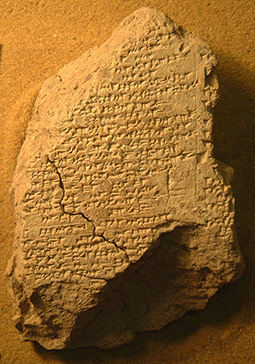
Image 3: Many deities had counterparts in the sky, as explained by the astronomical constellation list Mul-Apin (online translation: CTN 4: 28). British Museum, ND 5497/22. View large image (456 KB).
Just less than a quarter of the scholarly tablets from Kalhu are what Assyriologists TT now call lexical lists. They originate in scribal schooling, where their function is to teach students the elements and complexities of cuneiform script. They also drilled students in spelling and vocabulary, as well as the relationship between words in the Sumerian and Akkadian languages. The more advanced of these lists often found a place in collections of scholarly writings too, as they helped readers to find extra meanings in text through wordplay and manipulation of signs. They are often quoted in learned commentaries to standard works.
Most of the lexical lists from Kalhu are thematic vocabularies. The early chapters of Ura5 = hubullu contain business and legal expressions, followed by objects made of particular materials. Its commentary is called Mur-gud. Lu2 = šá is a list of professional titles, while malku = šarru, "king", gives synonyms for Akkadian TT words. The list known as Izi = išātu, "fire", groups words acrographically, that is by their initial signs, while Uludin2 = nabnītu, "creation", is based on parts of the body.
The Kalhu sign lists include E-a = A = nâqu "to wail", a logogram list ordered by the complexity of the logographic sign, and the closely related a2 = A = nâqu. Finally, the list DIRI = atru, "excess", explains the readings of compound DIRI = atru, "excess", which explains the readings of compound logograms.
Mobile libraries?
Much of scribal training focused on memorisation and recall of texts, so in principle mature scholars did not have to constantly look things up. However, in practice most communities of learned men accumulated collections of scholarly writings. They could be kept in the family home, stored in temple buildings, and/or moved around as needed. So while most of the scholarly tablets known from Kalhu come from Nabu's temple, Ezida, that only tells us what had been left there in the days and years before its destruction.
Small numbers of scholarly tablets have turned up in the Northwest Palace, in Room FF of the royal family's private quarters (CTN 2: 268–272, literary, ritual, lexical works (1)) as well as Rooms 4 and 25 the administrative wing (CTN 4: 27, 29: hymn, Enūma eliš). Similarly, Rooms H and S of the Governor's Palace yielded a tamītu prayer, a perfume recipe and a lexical text (CTN 2: 214-216). That doesn't necessarily mean that any of these locations normally housed a "library" of scholarly works. These tablets could just have been passing through.
We also know that the scholars kept scholarly works at home (Image 4). The Kalhu-based āšipu-healer Adad-šumu-uṣur PGP tells king Esarhaddon (SAA 10: 202):
Concerning what the king, my lord,wrote to me: 'Why haven't you sent an answer to (my) letter?'— I had to drive to the palace those rams that the chief cook had brought out for me, and the writing-board was at my house. Now then, I can look at the writing-board and extract the relevant interpretation. Concerning the ritual against earthquake [...]
It is likely, then, that Adad-šumu-uṣur and other members of the highly influential Gabbu-ilani-ereš family moved scholarly tablets as needed between Ezida, their homes, and wherever they were needed to serve the king and other clients. The scholar Nabu-zuqup-kenu PGP 's writings certainly got transferred to Nineveh at some point after his death. The elite scholars of Kalhu did not seem to protect their literary holdings. Unlike scribes TT elsewhere they did not tend to write injunctions or curses on their tablets to protect them from theft. This suggests that they were supremely confident that their knowledge was safely in their hands.
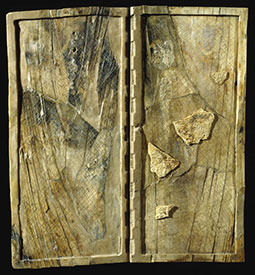
Image 5: Part of a set of sixteen writing boards hinged together as a folding set. The cuneiform inscription on the front cover says that they originally contained the omen series Enūma Anu Ellil, TT written for king Sargon's new city Dur-Šarruken but it was found down a well in Nimrud. Some fragments of inscribed wax remain. ND 3566, BM 131952. View large image on British Museum website. © The Trustees of the British Museum.
Nevertheless, whole collections of tablets could be moved wholesale, for instance to set up the new temple of Nabu at Dur-Šarruken PGP , or out again when it was suddenly abandoned. One writing-board of Enūma Anu Ellil TT destined for Dur-Šarruken was even thrown down a well at Kalhu (Image 5). Presumably the ill-fated city name inscribed on its front cover rendered it unuseable elsewhere. And maybe it was not only Nabu-zuqup-kenu's tablets that went to Nineveh in the early 7th century. It may have been more convenient for his descendants to have a working collection at the royal court rather than in what was now just a provincial TT capital.
In other words, the tablets that archaeologists have found at Nimrud does not represent the sum total of scholarly works that were composed and copied in ancient Kalhu. Some certainly got taken away. Older tablets, especially if they were not baked, could break and crumble. They could get lost in passing. Once integrated into archaeological strata TT they could get damaged or destroyed by later generations digging graves or foundations. It is certain, however, that very many more remain under the ground to be recovered by archaeologists still to come.
Content last modified: 18 Dec 2019
References
- Postgate, J.N., 1973. The Governor's Palace Archive (Cuneiform Texts from Nimrud 2), London: British School of Archaeology in Iraq (free PDF from BISI, 175 MB). (Find in text ^)
Eleanor Robson
Eleanor Robson, 'Scholarly works', Nimrud: Materialities of Assyrian Knowledge Production, The Nimrud Project at Oracc.org, 2019 [http://oracc.museum.upenn.edu/nimrud/ancientkalhu/thewritings/scholarlyworks/]
